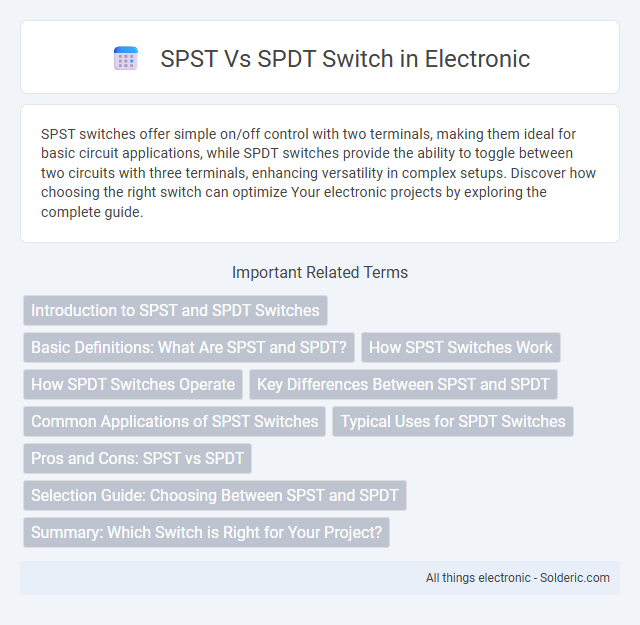SPST switches offer simple on/off control with two terminals, making them ideal for basic circuit applications, while SPDT switches provide the ability to toggle between two circuits with three terminals, enhancing versatility in complex setups. Discover how choosing the right switch can optimize Your electronic projects by exploring the complete guide.
Comparison Table
| Feature | SPST Switch | SPDT Switch |
|---|---|---|
| Definition | Single Pole Single Throw - simple ON/OFF switch | Single Pole Double Throw - one input, two output positions |
| Number of Poles | 1 | 1 |
| Number of Throws | 1 (ON/OFF) | 2 (alternate connections) |
| Functionality | Controls a single circuit on or off | Switches connection between two different circuits |
| Common Use Cases | Simple power control, light switches | Selector switches, mode selectors |
| Wiring Complexity | Simple wiring | More complex wiring for multiple outputs |
| Cost | Lower cost | Typically higher cost due to complexity |
Introduction to SPST and SPDT Switches
SPST (Single Pole Single Throw) switches are simple on-off switches that control one circuit by connecting or disconnecting a single line. SPDT (Single Pole Double Throw) switches allow one input to be connected to one of two outputs, enabling circuit redirection or selection. These switches are fundamental components in electrical circuits for controlling power flow and routing signals efficiently.
Basic Definitions: What Are SPST and SPDT?
SPST (Single Pole Single Throw) switches control a single circuit with two positions--on or off--making them ideal for simple power control applications. SPDT (Single Pole Double Throw) switches have one input and can connect to either of two outputs, allowing you to alternate between two circuits or devices. Understanding these basic definitions helps you select the appropriate switch for your electrical or electronic project needs.
How SPST Switches Work
SPST (Single Pole Single Throw) switches function by allowing or interrupting current flow through a single circuit, acting as a simple on/off control. When the switch is closed, it completes the circuit, enabling current to pass; when open, it breaks the circuit and stops the flow. You can use SPST switches in applications requiring straightforward control of electrical devices.
How SPDT Switches Operate
SPDT (Single Pole Double Throw) switches operate by connecting a common terminal to either of two other terminals, allowing users to switch between two circuits. These switches enable versatile circuit control by toggling the connection point, facilitating tasks such as selecting power sources or routing signals without interrupting circuit flow. SPDT switches provide a simple yet effective method for controlling multiple outputs from a single input.
Key Differences Between SPST and SPDT
SPST (Single Pole Single Throw) switches control one circuit with a simple on/off function, making them ideal for straightforward applications like lighting control. SPDT (Single Pole Double Throw) switches connect one input to one of two outputs, allowing you to toggle between two circuits or signal paths, providing greater versatility. Understanding these key differences ensures you select the right switch for your project's specific control needs.
Common Applications of SPST Switches
SPST switches are commonly used in simple on/off control applications such as household lighting circuits, power supply toggles, and basic electronic devices where a straightforward connectivity function is required. These switches provide a single input-output path, making them ideal for controlling small appliances, flashlight circuits, and other devices needing binary control. Their reliability and ease of installation make SPST switches essential components in automotive, industrial, and consumer electronics for switching circuits on or off.
Typical Uses for SPDT Switches
SPDT switches are commonly used in applications requiring the control of two circuits with one switch, such as selecting between two power sources or routing signals in audio and communication devices. They are ideal for toggling between different modes or functions, making them essential in control panels and multi-function devices. Your choice of an SPDT switch can simplify circuit design by enabling efficient signal or power switching without additional components.
Pros and Cons: SPST vs SPDT
SPST switches feature a simple on/off function with a single circuit path, offering reliability and ease of use but limited control options. SPDT switches provide two output options from one input, enabling more versatile circuit configurations but introducing complexity and potential for increased wear. Choosing between SPST and SPDT depends on whether straightforward operation or multifunctional control is prioritized in the application.
Selection Guide: Choosing Between SPST and SPDT
Selecting between SPST (Single Pole Single Throw) and SPDT (Single Pole Double Throw) switches depends on circuit requirements, where SPST is ideal for simple ON/OFF control with one input and output connection. SPDT switches offer more versatility by allowing one input to connect to either of two outputs, enabling circuit routing or alternate path selection. Choose SPST for straightforward power control and SPDT when switching between multiple circuits or controlling different loads is necessary.
Summary: Which Switch is Right for Your Project?
Choose an SPST switch for simple on/off control in circuits requiring a single path, commonly found in basic lighting or power applications. Select an SPDT switch when needing to toggle between two different circuits or outputs, offering versatile control in more complex projects like audio routing or motor direction. The decision depends on the project's circuit complexity and the required switch functionality for optimal performance.
SPST vs SPDT Switch Infographic

 solderic.com
solderic.com